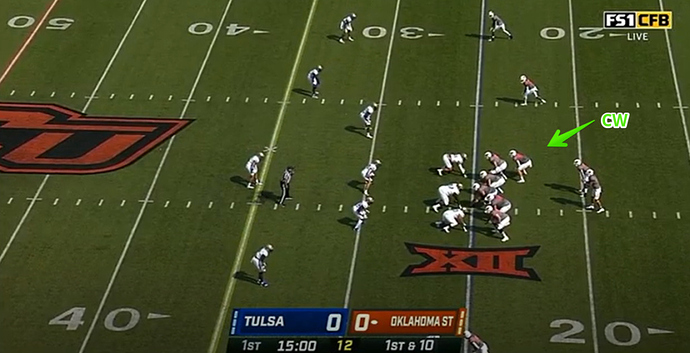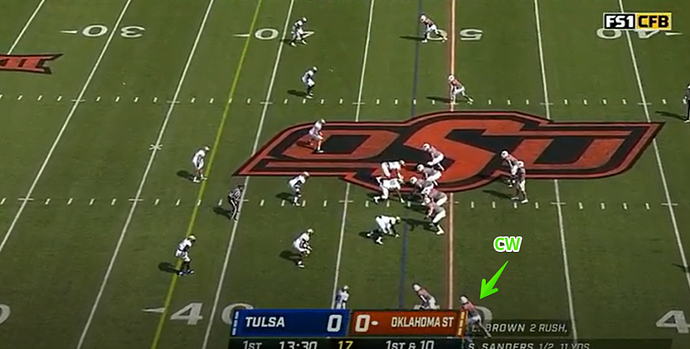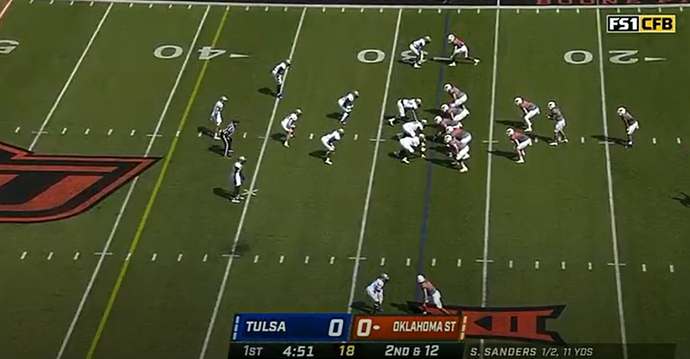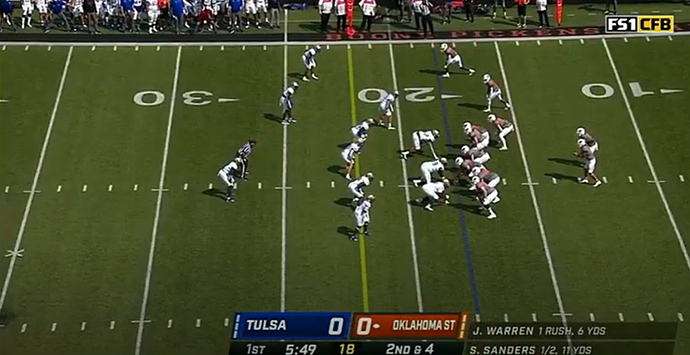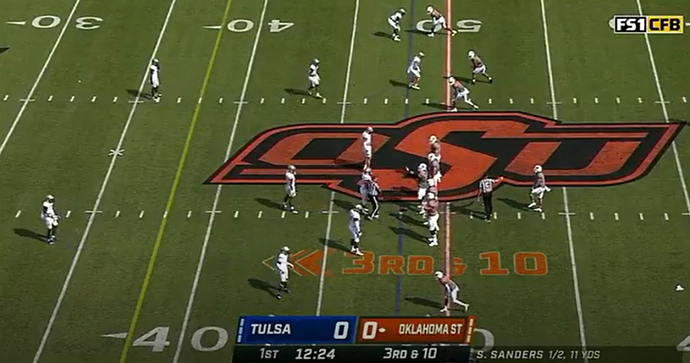Oklahoma State pulled out a 28-23 victory this past weekend against Tulsa. Quarterback Spencer Sanders played his first game of the season after sitting out the season opener. He went 15-of-26 for 173 yards and two touchdowns and threw one interception, which was returned for a touchdown. The Cowboys struggled again on the ground, and the running backs combined for just 87 yards on 30 carries (2.9 yards per carry). However, they were able to find the end zone one time.
The Cowboys were without wide receivers Tay Martin, who left the game early after trying to play through an injury he suffered against Missouri State, and Braydon Johnson. However, the young group of wideouts made some plays, and both Jaden Bray and Bryson Green had touchdown receptions on the day. Additionally, the offensive line played well at times, but they are still trying to figure things out as they moved some guys around from the group that played against MSU.
For Part 1 of this week's three-part offensive film study, I'll take a look at the overall scheme and what the Pokes were trying to accomplish against the TU defense on Saturday.
Personnel Groupings
As I mentioned above, OSU was without two of their starting receivers for their matchup against Tulsa, and you could tell this played a key role in the type of personnel groupings offensive coordinator Kasey Dunn put on the field. For comparison, here's how the personnel groupings shook out against Missouri State:
- 10 personnel: 30%
- 11 personnel: 42%
- 12 personnel: 9%
- 13 personnel: 7%
- 20 personnel: 12%
Now, here's the breakdown from the TU game:
- 10 personnel: 18%
- 11 personnel: 46%
- 12 personnel: 30%
- 13 personnel: 6%
Against the Bears, 58% of Cowboys' plays featured one or more Cowboy backs on the field. However, against the Golden Hurricane this increased to 82%. Even with the inexperience the Pokes have at the Cowboy back position, with the injuries at receiver, it seemed like Dunn opted to utilize the Cowboy backs more in his scheme against Tulsa. Also, with the way the Pokes ran the ball against MSU, I'm guessing Dunn opted to go with more heavy sets to try and help out the rushing attack.
Now, let's take a look at the run/pass splits out of each grouping. Although the Cowboys ran 69 total plays, I am only showing 66 below as I'm excluding the three kneels at the end of the game. Also, for this statistic, I'm counting one of the sacks as a running play, as it was QB Draw, and the other sack as a passing play.
10 personnel
- Pass - 11 plays (92%)
- Run - 1 play (8%)
11 personnel
- Pass - 11 plays (37%)
- Run - 19 plays (63%)
12 personnel
- Pass - 5 plays (25%)
- Run - 15 plays (75%)
13 personnel
- Pass - 0 (0%)
- Run - 4 plays (100%)
Lastly, let's look at the breakout by yards gained:
- 10 personnel: 82 yards (6.8 yards per play)
- 11 personnel: 137 yards (4.6 yards per play)
- 12 personnel: 90 yards (4.5 yards per play)
- 13 personnel: 17 yards (4.3 yards per play)
Overall Scheme
In regards to Tulsa's defensive scheme, the 3-3-5 look Tulsa bases out of has a lot of similarities to what Iowa State likes to do on that side of the ball. I wrote about about how TU's defense operates a couple of years ago. The Golden Hurricane's goal in the run game is plug up the inside with their talented defensive linemen and spill running backs to the outside where they are met by TU's second-level defenders. In pass coverage, we saw the Golden Hurricane operate mostly out of Cover 2 Zone and Cover 1 Man with some Cover 3 sprinkled in this past Saturday.
As mentioned above, the Cowboys primarily based out of 11 personnel. Their go-to formation from the Tulsa game featured one Cowboy back in an H-back position, with Twins (or two receivers) to one side and a lone receiver to the other. As shown in the image below.
They also went with a 2x2 look that featured the Cowboy back split wide, which is something we didn’t see much of in the Missouri State game.
The other formation we saw a few times was the “nub” tight end look shown below. Another look we didn’t see a lot of in Week 1, but something the Pokes did at times last year.
In the run game out of 11p, it was primarily Inside, Outside and Split Zone, and one GT Counter run. Dunn also added in some run-pass option (RPO) plays with Sanders back in at QB. In the passing game, we saw Double Slants, some vertical route/out route, high/low Cover 2 beating concepts, Slot Fades and some wide receiver screens mixed in.
Out of 12p, the Pokes went with the Diamond formation, which has been a staple of this offense in recent memory.
And, the formation below featuring a Cowboy back on the line of scrimmage and one in the H-back spot on the same side of the formation.
Dunn also did some interesting things out of 12 personnel, like the formation below which features a similar setup to the image above, but both receivers are split out to the same side of the formation that the Cowboy Backs are positioned. Leaving the left tackle as the farthest offensive player to the field, or wide side.
In 12p, Dunn stayed with the Zone running game, but mixed in a few Counters and QB Draw plays. There were only five passing plays run out of this personnel grouping, these consisted of wide receiver screens, quick passing concepts (slants and swing pass to RB) and one QB rollout.
Out of their 10 personnel looks, the Cowboys almost exclusively threw the football. It was primarily 2x2 sets and Trips, or three receiver, looks. Although they did go five-wide with a running back split out once as well.
In 13 personnel, OSU went with their I-formation look, shown below, and primarily ran Power, along with one designed QB run.
Conclusion
In terms of play calling, I didn't really like the Cowboys approached this game. A majority of the running plays were into the strength of the formation, and TU knew that was the plan. The Golden Hurricane started bringing more and more defenders into the box, and with the Cowboy offensive linemen struggling to get off their initial blocks and to the second level with the TU defensive linemen clogging the middle. There was no where for the OSU running backs to go. The Tape Doesn't Lie Podcast host and radio super star @AdamLunt showed a great example of this in his tweet below:
Overall, I thought the offensive line had an average game in terms of run blocking, but there were times when they still struggled to get a good push off the line of scrimmage. Tulsa's defensive lineman overpowered them on occasion. Now, TU's Jaxon Player and company are very talented, so I want to give them their credit as well. But, I still think the Poke O-linemen have to do a better job of being more physical in the rushing attack.
In addition, I think Sanders had some issues on the read plays. I'm not sure if Dunn is telling him to keep it in certain situations without making an actual read, but if he isn't, Sanders has to get more aggressive with pulling the ball and taking it himself. The TU defense was not truly respecting the threat of Sanders keeping it, and this led to the running backs getting stopped in the backfield by the read defender multiple times throughout this game.
In the passing game, I thought Sanders had a decent day, aside from a few bad throws I thought he had an "okay" debut performance. However, from a scheme perspective, I think you have to go to the wide receiver screens more often. We saw success with both Brennan Presley and John Paul Richardson on different types of wide receiver screens. To do this though, the Cowboys have to get better blocking from the receivers/Cowboy backs on the perimeter. They did a decent job, but the young guys need to keep improving.
Another note on the passing attack, is Tulsa came in with a nice game plan and executed it well. Lunt pointed out to me that Tulsa went with a lot of Cover 2 Zone against OSU's 2x2 sets. It seems like they were watching a lot of film on last season's bowl victory over Miami, when Presley dominated the Hurricanes' Cover 2 defense, and made an adjustment to key on the slot (Presley) while slow playing the deep route. And, it worked as Sanders had trouble progressing off the slot receiver when he was covered and wasn't able to get the ball to the sideline route.
I did like mixing in the RPOs in this one with Sanders back, and there were a lot of positive takeaways from this young receiver group. But, overall I just didn't think there was much flow or rhythm to this game plan once again.
Next up, I'll go into further detail on the Cowboy rushing attack in Part 2.
